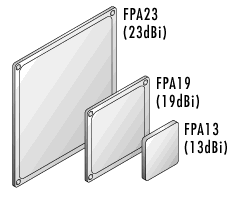DIRECTIONAL FLAT PANEL ANTENNAS - FPA and LPA
A directional antenna radiates in one direction giving increased gain. The gain of the antenna is determined by the number of elements. The more elements the higher the gain and the smaller the HPBW.
 The image to the right shows the relative size of antennas with different gain at the same frequency.
The image to the right shows the relative size of antennas with different gain at the same frequency.
Flat panel antennas can be highly directional with narrow azimuth and elevation radiation patterns for pinpoint accuracy in a communication network.
All antennas are tested to ensure that they meet their quoted specification, with supporting technical information and radiation pattern data available.
If the application requires a robust, discreet antenna mounted flat against a wall, or on a mast where a smaller antenna would be beneficial, this type of flat panel provides the best option. They can be painted to blend in with the surroundings.
Low wind loading and robust construction enable our antennas to be mounted in the most demanding of enviroments such as the Channel Tunnel Rail Link where trains travel through tunnels at speeds of up to 150 miles per hour. Another antenna is situated in a prominent position in St Pancras Internationa Station but, unless you know what you're looking for, you will not see it.
Characteristics
- Low profile
- Gain up to 32dBi
- Frequency range from 250MHz to 18GHz
- Multi-layered microstrip technology for bandwidths up to 15%
- Polarisation can be circular, linear or dual slant
- More efficient than dishes



